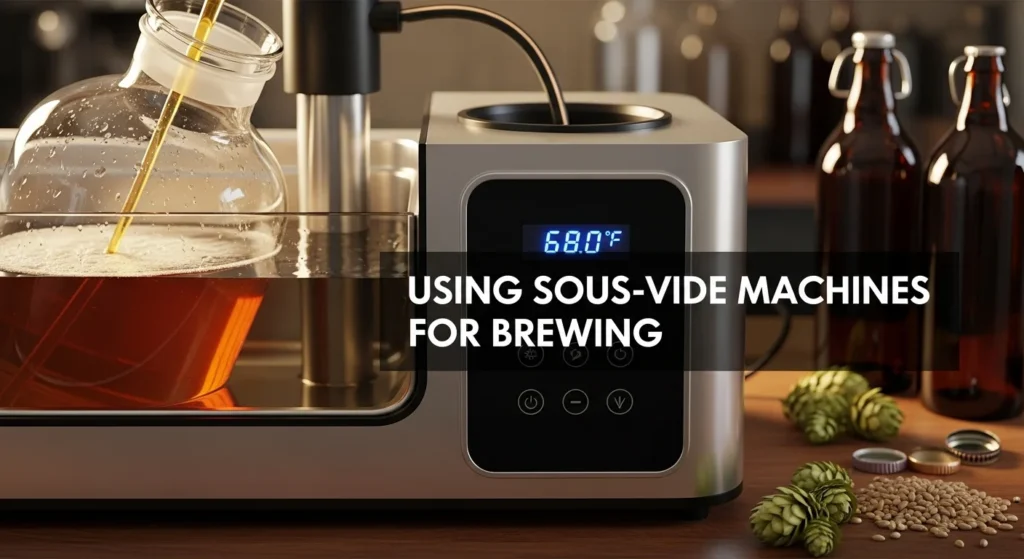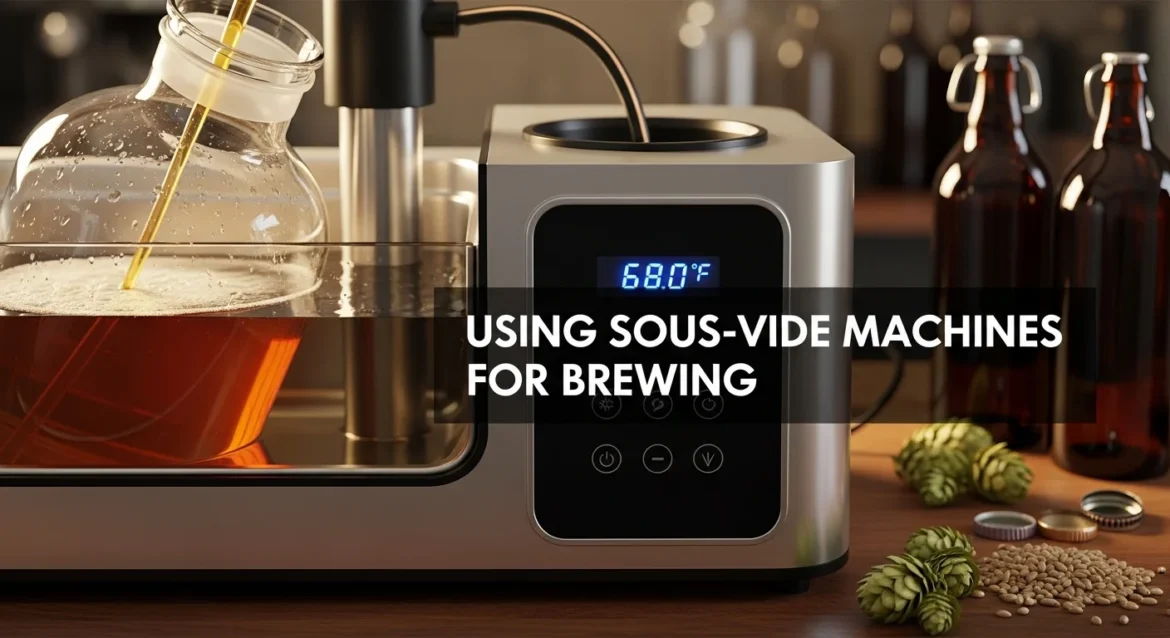Discover how to Using Sous-Vide Machines for Brewing revolutionize your homebrewing with sous-vide machines for precise temperature control. Learn mashing techniques, equipment selection, and advanced brewing applications that deliver professional results at home.

The integration of sous-vide technology into homebrewing represents one of the most significant advances in accessible precision brewing, enabling amateur brewers to achieve professional-level temperature control without expensive specialized equipment. After experimenting with various sous-vide applications across dozens of brewing sessions over the past five years, I can confidently state that immersion circulators have revolutionized my brewing consistency and opened possibilities for advanced techniques previously reserved for commercial operations.
My exploration of sous-vide brewing began with frustration over temperature fluctuations during mashing that affected extraction efficiency and flavor development. The breakthrough came when I realized that my kitchen sous-vide circulator could maintain mash temperatures within 0.1°F precision while providing gentle circulation that enhanced enzymatic activity and sugar extraction beyond traditional brewing methods.
This comprehensive guide explores every aspect of incorporating sous-vide machines into brewing processes, from basic mashing applications to advanced fermentation control and specialized techniques. Understanding proper implementation ensures optimal results while avoiding common pitfalls that could compromise beer quality or equipment performance.
Whether you’re seeking consistent mash temperatures, exploring temperature-stepped brewing processes, or pursuing advanced brewing control, mastering sous-vide applications expands your brewing capabilities while delivering professional results that reflect the precision possible with modern technology.
Understanding Sous-Vide Technology in Brewing Context
Sous-vide immersion circulators provide precise temperature control through heating elements and circulation pumps that maintain water temperature within extremely tight tolerances while ensuring even heat distribution throughout the brewing vessel.
Precision Temperature Control Benefits
Temperature accuracy within 0.1°F enables optimal enzyme activity during mashing while preventing the temperature overshoots that commonly occur with stovetop brewing methods. This precision directly translates to improved extraction efficiency and more consistent brewing results.
Circulation and Heat Distribution
The gentle circulation provided by immersion circulators prevents temperature stratification while promoting even enzyme distribution throughout the mash. This circulation enhances sugar extraction by ensuring consistent grain-to-water contact and optimal enzymatic conditions throughout the entire mash volume.
Energy Efficiency and Control
Sous-vide machines typically consume 800-1200 watts while providing superior temperature stability compared to gas burners or electric stoves that cycle on and off creating temperature fluctuations. The consistent heating reduces energy waste while improving brewing consistency.
Integration with Existing Equipment
Modern immersion circulators adapt to virtually any brewing vessel through clamp-on designs that require no permanent modifications while enabling precise temperature control in existing pots, kettles, and mash tuns.
For comprehensive brewing precision techniques and advanced temperature control strategies, explore the detailed resources at BrewMyBeer’s precision brewing guides, where professional brewing accuracy meets practical homebrewing applications.
Using Sous-Vide Machines for Brewing Mashing Applications and Techniques
Mashing represents the most impactful application of sous-vide technology in brewing, enabling precise enzymatic control that optimizes sugar extraction while maintaining ideal conditions for starch conversion and protein modification.
Strike Water Temperature Control
Precise strike water heating eliminates temperature guesswork while ensuring optimal grain hydration and enzyme activation. Set the circulator to desired strike temperature and achieve perfect conditions without overshooting or undershooting that affects initial enzyme activity.
Mash Temperature Maintenance
Once mashing begins, the circulator maintains exact temperature throughout the entire process without the temperature drift common in traditional mashing methods. This consistency enables optimal enzyme performance and complete starch conversion.
Temperature Step Mashing Protocol
Advanced brewers can execute precise temperature step programs by programming temperature increases at specific intervals. The gradual temperature ramping activates different enzymes sequentially for enhanced control over body, fermentability, and flavor development.
Brew-in-a-Bag Integration
BIAB methods benefit significantly from sous-vide integration since the grain bag protects the circulator while enabling full temperature control. Position the circulator outside the grain bag to prevent clogging while maintaining optimal circulation.
Efficiency Improvements
Brewers consistently report 5-15% efficiency improvements when using immersion circulators due to better temperature control and enhanced circulation that improves sugar extraction from the grain bed.
| Mashing Parameter | Traditional Method | Sous-Vide Method | Improvement |
|---|---|---|---|
| Temperature Accuracy | ±3-5°F | ±0.1°F | 30-50x better |
| Temperature Stability | Variable drift | Rock steady | Eliminates variables |
| Extraction Efficiency | 70-75% | 75-85% | 5-15% increase |
| Labor Requirements | Constant monitoring | Set and forget | Hands-free operation |
Equipment Selection and Setup Requirements
Choosing appropriate sous-vide equipment for brewing requires understanding power requirements, capacity limitations, and compatibility factors that ensure optimal performance and longevity.
Circulator Power and Capacity
Most homebrewing applications require 1000+ watt circulators to handle the thermal mass of 5-8 gallon brewing volumes effectively. Higher wattage units heat faster and maintain temperature better when working with large volumes typical in brewing.
Popular Brewing-Suitable Models
Anova Precision Cooker, Joule by ChefSteps, and similar professional-grade circulators provide adequate power and reliability for brewing applications. Specialized brewing circulators like BrewVide offer brewing-specific features but may not be necessary for most applications.
Vessel Compatibility and Setup
Standard brewing kettles and pots work excellently with immersion circulators through clamp-on mounting systems. Ensure adequate water depth (typically 2.5-4 inches) for proper circulator operation while maintaining clearance from grain bags or other brewing materials.
Safety and Protection Considerations
Use GFCI protection for all electrical brewing equipment while ensuring the circulator remains properly positioned to prevent contact with grain particles that could damage the pump or heating element.
Cleaning and Maintenance Integration
Immediate cleaning after brewing sessions prevents buildup of sugars and proteins that could affect circulator performance. Simple vinegar solutions effectively clean heating elements and circulation systems.
Advanced Brewing Applications
Beyond basic mashing, sous-vide technology enables sophisticated brewing techniques including fermentation control, yeast propagation, and specialized processing methods that expand brewing possibilities.
Fermentation Temperature Control
Immersion circulators excel at maintaining fermentation temperatures for temperature-sensitive yeasts including saison strains and kveik varieties that require elevated temperatures. Place fermenters in water baths controlled by circulators for precise fermentation management.
Yeast Starter Optimization
Precise temperature control during yeast starter preparation improves yeast health and viability while enabling optimal growth conditions that produce more vigorous fermentations and cleaner flavor profiles.
Hop Oil Extraction and Processing
Controlled temperature extraction techniques enable enhanced hop oil extraction for concentrated flavor additions while preventing volatile loss that occurs with traditional boiling methods.
Specialized Beer Styles
Temperature-sensitive styles including lagers, wheat beers, and traditional European styles benefit from precise temperature control throughout brewing and fermentation phases that replicate traditional production methods.
Water Treatment and Preparation
Controlled heating for water treatment including chloramine removal and mineral adjustment ensures optimal brewing water while eliminating chlorine compounds that could affect yeast performance or beer flavor.
Integration with Different Brewing Methods
Sous-vide technology adapts to various brewing methodologies while enhancing each approach through improved temperature control and process consistency.
All-Grain Brewing Enhancement
Traditional all-grain brewing benefits significantly from precise mash temperature control while the circulation improves lauter efficiency and reduces stuck mashes through better grain bed dynamics and temperature uniformity.
Extract Brewing Applications
Even extract brewing improves with precise temperature control during specialty grain steeping phases while enabling optimal yeast rehydration and fermentation temperature management throughout the brewing process.
Partial Mash Integration
Partial mash brewing combines extract convenience with all-grain quality through controlled mashing of specialty grains. Sous-vide precision ensures optimal extraction from specialty grains while maintaining process simplicity.
High-Efficiency Brewing Systems
Commercial-style brewing systems integrate excellently with immersion circulators for enhanced temperature control that rivals expensive automated brewing equipment while maintaining cost-effectiveness.
Cost-Benefit Analysis and Investment Considerations
Understanding the financial implications of sous-vide brewing helps evaluate equipment investment against performance improvements and long-term brewing benefits.
Initial Equipment Investment
Quality immersion circulators cost $100-300 compared to dedicated brewing temperature controllers costing $200-500+. The versatility of sous-vide units provides value beyond brewing through culinary applications that justify the investment.
Efficiency and Ingredient Savings
Improved extraction efficiency reduces grain costs by 5-15% through better sugar utilization while more consistent batches reduce waste from failed or suboptimal brews that require dumping or correction.
Time and Labor Savings
Automated temperature control reduces active brewing time while enabling multitasking during long mashing periods. The hands-off operation allows attention to other brewing tasks or activities while maintaining optimal conditions.
Quality Improvements and Consistency
Enhanced consistency and quality justify equipment costs through better beer that reflects improved brewing precision and control over critical variables that affect final beer character and quality.
Long-Term Value and Versatility
Dual-purpose equipment provides ongoing value through both brewing and culinary applications while building advanced brewing skills that enhance overall brewing capability and satisfaction.
Safety Considerations and Best Practices
Sous-vide brewing requires attention to electrical safety, equipment protection, and proper procedures that ensure safe operation while maintaining optimal performance and equipment longevity.
Electrical Safety and GFCI Protection
All electrical brewing equipment requires GFCI protection to prevent shock hazards in wet brewing environments. Ensure proper electrical installation and avoid extension cords that could create safety hazards or voltage drops affecting performance.
Equipment Protection Strategies
Position circulators to avoid grain particle contact that could damage pumps or heating elements while maintaining adequate water depth for proper operation throughout the brewing session.
Temperature Monitoring and Backup Systems
Independent temperature monitoring provides backup verification of circulator accuracy while enabling early detection of equipment malfunctions that could compromise batch quality or create safety concerns.
Proper Cleaning and Maintenance
Immediate post-brew cleaning prevents residue buildup that could affect performance while regular maintenance ensures optimal operation and extends equipment life through proper care and attention.
Emergency Procedures and Contingency Planning
Understand backup heating methods and emergency procedures for equipment failures while maintaining brewing schedules and quality standards despite unexpected equipment issues.
Optimization Tips and Advanced Techniques
Maximizing sous-vide brewing performance requires understanding advanced techniques and optimization strategies that enhance results while avoiding common mistakes that could compromise brewing quality.
Circulation Optimization
Proper positioning maximizes circulation benefits while preventing dead zones where temperature stratification could occur. Strategic placement ensures even heat distribution throughout the mash volume.
Programming and Automation
Advanced circulators enable step-mashing programs that automatically execute temperature changes at predetermined intervals. This automation enables complex mashing schedules without manual intervention or timing concerns.
Multi-Vessel Applications
Using multiple circulators enables simultaneous control of strike water, sparge water, and fermentation temperatures while coordinating complex brewing schedules that optimize efficiency and timing.
Data Logging and Analysis
Modern connected circulators provide brewing data including temperature profiles and timing that enable process analysis and optimization through systematic documentation and trend analysis.
Integration with Brewing Software
Advanced setups integrate with brewing software for comprehensive process control and documentation that supports systematic brewing improvement and quality consistency.
Troubleshooting Common Issues
Understanding typical problems and solutions prevents brewing disruptions while ensuring optimal performance from sous-vide equipment throughout extended brewing sessions.
Temperature Accuracy and Calibration
Periodic calibration verification ensures continued accuracy while identifying potential issues before they affect brewing results. Simple ice-water and boiling-water tests verify calibration accuracy and identify drift requiring attention.
Circulation and Flow Problems
Reduced circulation often indicates pump issues or debris interference requiring cleaning or repositioning. Understanding circulation patterns helps optimize placement while preventing performance degradation.
Power and Electrical Issues
Voltage variations and electrical problems can affect heating performance and temperature stability. Understanding electrical requirements and troubleshooting procedures enables rapid problem resolution and continued brewing.
Equipment Maintenance and Longevity
Regular maintenance prevents problems while extending equipment life through proper care and attention to cleaning procedures and operational guidelines that preserve performance.
Future Developments and Technology Trends
Emerging technologies and brewing applications promise enhanced capabilities while addressing current limitations and expanding possibilities for precision brewing control.
Smart Technology Integration
Connected circulators with smartphone apps enable remote monitoring and control while providing brewing data and analysis capabilities that support systematic brewing improvement and optimization.
Advanced Control Systems
Integrated brewing control systems combining circulation, heating, and monitoring provide comprehensive brewing automation while maintaining cost-effectiveness and accessibility for homebrewers.
Specialized Brewing Applications
Emerging applications including pressure fermentation control, carbonation management, and advanced processing techniques expand the utility of precision temperature control in brewing operations.
Energy Efficiency Improvements
Advanced heating and circulation technologies promise improved energy efficiency while maintaining precision control that reduces operating costs and environmental impact.
Conclusion and Implementation Strategy
Sous-vide technology represents a transformative addition to any serious homebrewer’s equipment arsenal while providing professional-level temperature control at accessible costs and complexity levels.
For beginners, start with basic mashing applications using existing immersion circulators to experience precision temperature control benefits while building familiarity with the technology and brewing integration requirements.
Advanced brewers can explore sophisticated applications including multi-step mashing, fermentation control, and specialized processing techniques that leverage precision temperature control for enhanced brewing quality and consistency.
Budget-conscious brewers should consider the dual-purpose value of immersion circulators that serve both brewing and culinary functions while providing immediate brewing improvements that justify the investment through better results.
Remember that successful sous-vide brewing requires understanding proper techniques and safety procedures while maintaining equipment appropriately to ensure optimal performance and longevity throughout extended brewing applications.
The investment in sous-vide brewing capability provides lasting value through improved consistency, enhanced quality, and expanded brewing possibilities that reflect the precision achievable through modern temperature control technology.
Choose equipment based on actual brewing requirements and growth plans rather than maximum features, focusing on reliable units that provide consistent performance throughout demanding brewing applications.
About the Author
Dave Hopson is a beer enthusiast who travels the world to explore different beer styles, brewing techniques, and local brewing traditions. With over a decade of experience in craft beer culture and advanced brewing technology, Dave brings unique insights to precision brewing through his understanding of how temperature control affects beer quality across diverse brewing traditions and modern applications. His expertise spans traditional brewing methods and cutting-edge brewing technology, with particular focus on how precision equipment like sous-vide machines can replicate and enhance traditional brewing techniques from around the world.
Dave’s extensive travels have exposed him to diverse brewing environments and temperature control methods, from traditional German lager cellars to modern craft breweries utilizing advanced automation. He writes about brewing innovation, technology integration, and the intersection of traditional brewing craftsmanship with modern precision equipment, helping brewers understand how tools like immersion circulators can enhance rather than replace time-honored brewing techniques. Dave’s analytical approach combines cultural brewing knowledge with practical technology implementation, ensuring his recommendations reflect both brewing authenticity and real-world performance benefits. Contact Dave at [email protected] or explore his comprehensive brewing guides and precision brewing analysis at brewmybeer.online.

